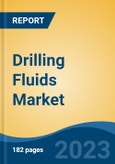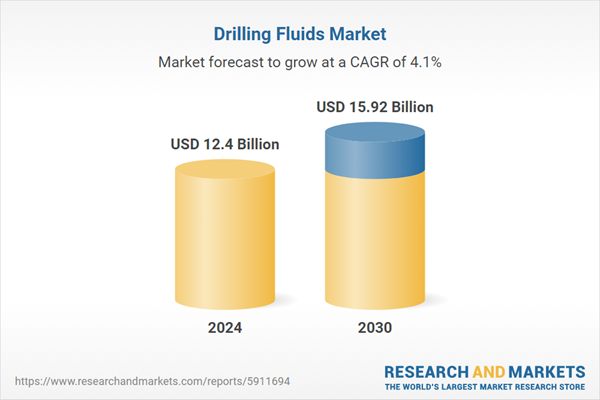Free Webex Call
The Drilling Fluids Market was valued at USD 12.4 Billion in 2024, and is expected to reach USD 15.92 Billion by 2030, rising at a CAGR of 4.10%. The market is expanding significantly, driven by the increasing demand for advanced and efficient drilling technologies in the oil and gas sector. Drilling fluids, or muds, are crucial for lubricating drilling equipment, stabilizing wellbore pressure, and preventing blowouts during drilling operations. As exploration and production activities expand, particularly in offshore and unconventional oil reserves, the demand for specialized drilling fluids is rising. This growth is further fueled by a focus on environmentally friendly, non-toxic fluid formulations and the adoption of digital technologies to optimize fluid management. Speak directly to the analyst to clarify any post sales queries you may have.
10% Free customizationThis report comes with 10% free customization, enabling you to add data that meets your specific business needs.
Key factors driving the market's expansion include rising global energy consumption, advancements in drilling techniques, and the expansion of exploration activities in deep-water and challenging environments. The increased use of water-based, oil-based, and synthetic-based fluids for specific applications is diversifying the market. As oil prices stabilize and global energy demand grows, investments in oilfield services are expected to rise, further boosting the drilling fluids market. North America and the Middle East are currently the largest markets, driven by extensive oil and gas operations. With an emphasis on operational efficiency, safety, and sustainability, the drilling fluids market is poised for continuous innovation, providing opportunities for manufacturers to meet evolving industry demands.
Key Market Drivers
Rising Global Energy Demand
A major driver for the growth of the Global Drilling Fluids Market is the increasing global demand for energy. As nations and industries prioritize securing reliable and diverse energy sources, oil and gas exploration activities are intensifying, particularly in untapped reserves, deep-water, and unconventional fields. This surge in exploration and production directly correlates with the growing demand for advanced drilling fluids that ensure safety, efficiency, and reliability. Rising energy consumption, particularly in emerging economies experiencing industrial growth and urbanization, is further driving the need for drilling in challenging and remote locations.Drilling fluids are vital for maintaining wellbore stability, optimizing performance, and mitigating operational risks. This growing energy demand fuels investments in innovative drilling fluid technologies to support complex environments, contributing to market expansion. In 2023, global energy consumption increased by 2.2%, surpassing the average growth rate of 1.5% per year observed between 2010 and 2019. This acceleration was largely driven by the BRICS nations, which accounted for 42% of global energy consumption.
Key Market Challenges
Environmental Impact and Sustainability Concerns
One of the primary challenges facing the Global Drilling Fluids Market is the environmental impact of drilling operations, particularly concerning the disposal and composition of drilling fluids. Traditional oil-based fluids, in particular, pose significant environmental risks due to their toxicity and potential contamination of soil and water sources. As a result, regulatory bodies and the public are placing increasing pressure on the industry to reduce the environmental footprint of drilling activities. This challenge is compounded by stringent environmental regulations, which vary by region, complicating compliance for global drilling operations.Companies are under continuous scrutiny to adopt sustainable alternatives, such as biodegradable and non-toxic fluids, but developing these solutions while maintaining cost-effectiveness and operational performance remains a significant hurdle. Furthermore, the disposal of used drilling fluids presents an ongoing challenge, as improper handling can lead to environmental damage, financial penalties, and reputational harm. The industry must balance sustainability concerns with the need for efficient, reliable, and cost-effective solutions, making this a critical challenge for continued market growth.
Key Market Trends
Shift Towards Environmentally Friendly Drilling Fluids
A notable trend in the Global Drilling Fluids Market is the growing shift toward environmentally friendly and sustainable fluid solutions. With heightened global awareness of environmental protection, both regulatory bodies and the public are demanding more sustainable practices in the oil and gas sector. Consequently, there has been an accelerated adoption of water-based and biodegradable drilling fluids, which offer a lower environmental impact compared to traditional oil-based alternatives. This push for sustainable solutions is driven not only by regulatory requirements but also by drilling companies’ desire to improve their environmental footprint and reputation.Many countries have introduced stricter environmental regulations, particularly regarding the disposal of drilling fluids and waste, making eco-friendly solutions essential for compliance. Manufacturers are investing heavily in research and development to create innovative fluids that balance performance with sustainability, focusing on reducing toxicity, enhancing biodegradability, and minimizing water usage. Advances in green chemistry are also leading to the development of new fluid technologies that provide the necessary functionality without compromising environmental safety. This trend is expected to continue as the oil and gas industry moves toward cleaner practices, offering opportunities for companies to develop and market sustainable fluid solutions that meet both operational and environmental goals.
Key Market Players
- Halliburton Energy Services, Inc.
- Baker Hughes Company
- CES Energy Solutions Corp.
- Newpark Resources, Inc.
- Petrochem Performance Chemicals LLC
- Schlumberger Limited
- Weatherford International plc
- Odfjell Drilling Ltd.
Report Scope
This report segments the Global Drilling Fluids Market into the following categories, with additional industry trends outlined:
Drilling Fluids Market by Well Type:
- Conventional Wells
- High-Pressure High-Temperature (HPHT) Wells
Drilling Fluids Market by Fluid System:
- Water-Based System
- Oil-Based System
- Synthetic-Based System
- Others
Drilling Fluids Market by Application:
- Onshore
- Offshore
Drilling Fluids Market by Region:
North America:
United States, Canada, MexicoEurope:
France, United Kingdom, Italy, Germany, Spain, BelgiumAsia-Pacific:
China, India, Japan, Australia, South Korea, Indonesia, VietnamSouth America:
Brazil, Argentina, Colombia, Chile, PeruMiddle East & Africa:
South Africa, Saudi Arabia, UAE, Turkey, IsraelCompetitive Landscape
The competitive landscape section provides a detailed analysis of the major companies operating in the Global Drilling Fluids Market.Available Customizations
TechSci Research offers customization options for the Global Drilling Fluids Market report, tailored to specific company needs. The following customizations are available:
- Detailed analysis and profiling of additional market players (up to five).
This product will be delivered within 1-3 business days.
Table of Contents
1. Product Overview
2. Research Methodology
6. Global Drilling Fluids Market Outlook
7. North America Drilling Fluids Market Outlook
8. Europe Drilling Fluids Market Outlook
9. South America Drilling Fluids Market Outlook
10. Middle East & Africa Drilling Fluids Market Outlook
11. Asia Pacific Drilling Fluids Market Outlook
12. Market Dynamics
14. Company Profiles
Companies Mentioned
- Halliburton Energy Services, Inc.
- Baker Hughes Company
- CES Energy Solutions Corp.
- Newpark Resources, Inc.
- Petrochem Performance Chemicals LLC
- Schlumberger Limited
- Weatherford International plc
- Odfjell Drilling Ltd.
Table Information
| Report Attribute | Details |
|---|---|
| No. of Pages | 180 |
| Published | February 2025 |
| Forecast Period | 2024 - 2030 |
| Estimated Market Value ( USD | $ 12.4 Billion |
| Forecasted Market Value ( USD | $ 15.92 Billion |
| Compound Annual Growth Rate | 4.1% |
| Regions Covered | Global |
| No. of Companies Mentioned | 8 |









